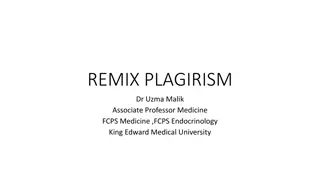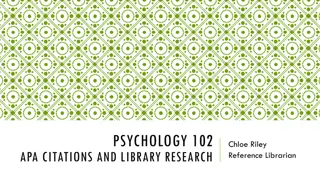Understanding Plagiarism and Proper Citation in Academic Writing
Understanding plagiarism is crucial to avoid claiming others' work as your own. This includes copying, failing to cite sources, and incorrectly paraphrasing. Proper citation, such as in-text citations and works cited, is essential to give credit to original sources. Different citation styles, like MLA and APA, are used based on the subject area. Remember to cite books, articles, websites, and interviews to acknowledge the ideas you use in your work.
Uploaded on Dec 09, 2024 | 0 Views
Download Presentation

Please find below an Image/Link to download the presentation.
The content on the website is provided AS IS for your information and personal use only. It may not be sold, licensed, or shared on other websites without obtaining consent from the author. Download presentation by click this link. If you encounter any issues during the download, it is possible that the publisher has removed the file from their server.
E N D
Presentation Transcript
What is it? How can you avoid it? Created by: Ms. Henry Mrs. Glynn
Vocabulary needed for this lesson: Plagiarism: claiming another s work or ideas as your own. Original source: the source from which you quote or paraphrase. This can be a book, article, website, database article, interview, television show, song, documentary, movie, performance, work of art, map, radio program, lecture, legal source, government publication, pamphlet, personal letter, etc. Paraphrase: a restatement (in your own words and style) of a passage found in an original source. Changing two words in a ten word sentence is not paraphrasing. Direct quotation: someone s exact words, phrases, or sentences used in your text. Such a quotation should preserve the original author s intent. In-text citation (internal citation): directions for your reader for finding the original source in your list of works cited. This usually takes the form of the author s last name and page number in parentheses. Works cited: your list of each source used in your project and its publication information. This enables your reader to find your original sources.
What is plagiarism? copying another student s paper, answers or homework passing off another person s ideas as your own failing to cite quotations and borrowed ideas failing to put paraphrases and summaries in your own words failing to enclose another person s language or words in quotation marks incorrectly citing
Using other peoples ideas is not plagiarism. you are supposed to build upon others research/ideas. You should use the ideas of others to come to your own conclusions, but you must give proper credit.
How should you cite? Generally, MLA style is used for humanities, APA style is used for psychology and other social sciences, and Chicago style has been used in history and some humanities classes; check with your teacher for which style he/she prefers. For MLA style, the general rule is to place the author s last name and the page number of the original text in parentheses after the quotation or paraphrase. For example, (Smith 23). This short citation will enable your reader to find your full citation on the list of works cited at the end of your paper or assignment.
What should you cite? books, articles, websites, interviews, etc. from which you quote Some famous artists of colonial America include John Durand, John Greenwood, Charles Willson Peale and Justus Engelhardt K hn, but some thought [t]he most talented artist of colonial America was John Singleton Copley, who began painting in Boston at the age of fourteen (Glubok 25). Copley is most famous for his portrait work. This is a direct quotation from a book by Shirley Glubok, page 25. The first t in the quotation is in brackets because the author of the paper changed a capital T to lower case to fit in his/her sentence.
The corresponding works cited entry would look like this: Glubok, Shirley. The Art of Colonial America. Macmillan, 1970.
Here is another example from an essay on The Witch of Blackbird Pond: Kit shows herself to be ignorant of her cousins lifestyle when she unpacks her bags. When Judith asks what is in the trunk, she replies, Well, dresses and petticoats, and slippers, and such. You have the same things yourselves, don t you? (40). Such a statement shows Kit s lack of awareness; she should have known from the simple home they lived in that they did not have such things. Since this is the only source used in the essay, you do not need to include the author s last name.
The corresponding works cited entry would look like this: Speare, Elizabeth George. The Witch of Blackbird Pond. Houghton Mifflin, 1958.
books, articles, websites, interviews, etc. from which you paraphrase summaries of someone else s ideas In the 1600s, the Sioux Indians began to migrate north and west from the Eastern woodlands. At this time, they became dependent upon the buffalo for food, clothing and shelter. The tribes would follow the herd, never putting down roots. Therefore, they were not agricultural at all. They would eat buffalo, both fresh and dried, bear, deer and antelope. Also, the women would gather wild fruits and vegetables (Brooks 7-8). This is a paraphrase of several paragraphs, or a summary of material. There are no direct quotations, so no quotation marks are used.
The corresponding works cited entry would look like this: Brooks, Barbara. Native American People: The Sioux. Rourke Publishing, 1989.
facts not widely known. You will not be penalized for citing a common fact, but not citing when it is needed is plagiarism and will result in negative consequences. When in doubt, cite your source. opinions of others Do you enjoy Dijon mustard or Roquefort cheese? How about bouillabaisse? If so, you have the French to thank. These are just some of the wonderful tastes of France. The French so love their food that they often elevate their three star chefs to celebrity status (Steele 33). Although this paraphrase may include a fact of which many people are aware, the information is not necessarily common knowledge, and therefore it must be cited.
The corresponding works cited entry would look like this: Steele, Ross. The French Way: Aspects of Behavior, Attitudes, and Customs of the French. Passport Books, 1995.
Here is another example. This one is from an online database article: Much of the table salt that you put on your eggs comes from seawater which flows into shallow pools and is heated and bleached white by sunlight. The top layer is scraped off and cleaned, then milled until it is a fine consistency. This sea salt is then shipped off and eventually ends up in a shaker on your table (Scarborough). Here is a fact that could be looked up and found in many places, but you wouldn t consider it common knowledge, so it must be cited. Notice there is no page number. That is because this is from an online article.
The corresponding works cited entry would look like this: Scarborough, Ramona. "Salt of the Earth." Faces: People, Places, and Cultures Apr. 2016: 26+. Student Resources in Context. 18 Sept. 2016. http://ic.galegroup.com.
Some additional items to cite: visuals (maps, charts, pictures, etc.) help provided by a friend, tutor, instructor or parent
The preceding examples are from various sources on unrelated topics. However, if we were to create a works cited page that includes all of them, it would look like this:
Works Cited Brooks, Barbara. Native American People: The Sioux. Rourke Publishing, 1989. Glubok, Shirley. The Art of Colonial America. Macmillan, 1970. Scarborough, Ramona. "Salt of the Earth." Faces: People, Places, and Cultures Apr. 2016: 26+.Student Resources in Context. 18 Sept. 2016. http://ic.galegroup.com. Speare, Elizabeth George. The Witch of Blackbird Pond. Houghton Mifflin, 1958. Steele, Ross. The French Way: Aspects of Behavior, Attitudes, and Customs of the French. Passport Books, 1995.
How do you find the proper format for in-text citations and works cited pages for articles, books, websites, database articles and other materials you will use? Go to http://owl.english.purdue.edu. Follow the link to Research and Citations. This is an excellent site by the Purdue University Writing Lab which gives formatting information on both APA and MLA styles. If you forget this URL, go to the English section of the high school website. Click on the Owl at Purdue link. You can also Google owl at Purdue. The first entry will be the one you want. Go to citationmachine.net or easybib.com. For each, try to use the latest version of MLA, which is MLA 8.
Reasons people plagiarize: Wanting to be perceived as smart or knowledgeable/ being afraid of being perceived as ignorant about a subject. Teachers assign research projects so you will learn the subject matter. Being overwhelmed. Good time management habits will diminish this feeling. Laziness. Fear of failure or poor grades. Carelessness. Unintentional plagiarism occurs when someone is careless or doesn t know the rules for citation. Now that you know the rules, you can avoid this problem.
Some of the consequences of plagiarism may be: A zero on the assignment. 0, 85, 90, 88, 100, 92, 90, 87, 96,91= 81.9 Note how the zero affects this student s average. Even if the student had turned in a weak paper (grade of 70), his/her average would not suffer so severely: 70, 85, 90, 88, 100, 92, 90, 87, 96, 91= 88.9 A 70 on the paper results in a 7 point difference in the average for the quarter.
Consequences continued: A do-over. If the teacher allows you to make up a plagiarized assignment, for full or partial credit, how will that affect your weekend? A stained academic reputation. Will teachers trust you in the future? How will teachers feel about writing a college recommendation for you? Denial of admission to or dismissal from the Junior National Honor Society. This has occurred at Cold Spring Harbor High School. A strained relationship with a friend. If you copy an assignment from a friend, both of you will suffer consequences. In the future, academic probation or expulsion from college. The loss of your job.
Things to remember: When using others ideas or words in any assignment, you must cite your sources. To find out how to do this properly, consult a style handbook, find an online resource, or ask your teacher. Budget your time wisely. By allotting yourself enough time for each step in the research process, you will avoid making mistakes. Value your academic reputation; avoid plagiarism!























